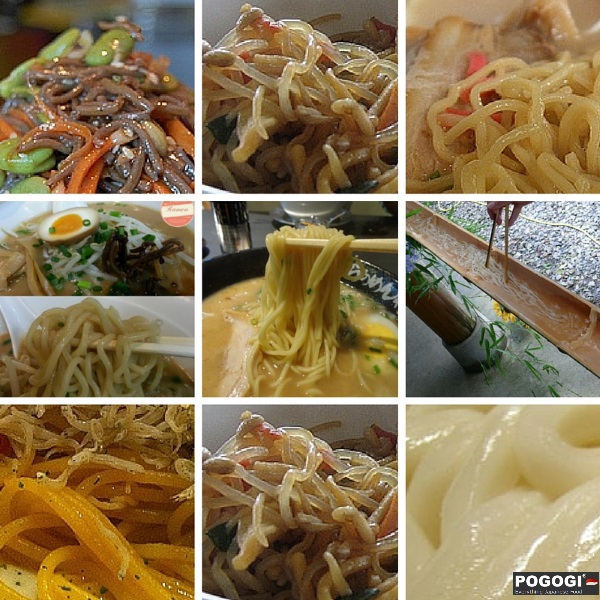Delicious Adventures: Exploring The World Of Japanese Noodles
Japanese noodles are more than just food—they're a cultural phenomenon that has taken the world by storm. From ramen joints in Tokyo to instant noodle cups in dorm rooms, these humble strands of dough have become a global obsession. But what makes Japanese noodles so special? Let’s dive into the delicious world of noodles and uncover the secrets behind their irresistible charm.
Picture this: you're sitting at a cozy little noodle shop in Japan, steam rising from a bowl of perfectly cooked ramen. The broth is rich, the toppings are fresh, and the noodles have that perfect chewy texture that makes you want to savor every bite. Japanese noodles aren’t just about taste—they’re an experience. Whether you're slurping soba on a chilly winter day or enjoying cold somen in the summer, there’s something magical about these dishes.
But let’s be real here, folks. Japanese noodles aren’t just for foodies or travel enthusiasts. They’ve made their way into kitchens and restaurants all over the world, proving that good food knows no boundaries. So whether you're a seasoned noodle connoisseur or a curious beginner, this article is here to take you on a flavorful journey through the land of Japanese noodles.
Read also:Discovering The Most Dangerous Zodiac Sign When Angry Unveiling Astrological Insights
Why Japanese Noodles Are a Global Sensation
Let’s talk about why Japanese noodles have become such a big deal. Sure, pasta and spaghetti are great, but there’s something unique about Japanese noodles that sets them apart. First off, the variety is insane. You’ve got ramen, udon, soba, somen, and even lesser-known types like hiyamugi and champon. Each type of noodle brings its own personality to the table, and that’s what makes them so fascinating.
Another reason Japanese noodles have taken the world by storm? The broth. Oh, the broth! Whether it's a creamy miso ramen or a savory soy-based udon, the broth is the star of the show. And let’s not forget the toppings—everything from tender pork slices to soft-boiled eggs adds layers of flavor and texture that keep you coming back for more.
The Rich History of Japanese Noodles
Japanese noodles haven’t always been the global sensation they are today. Their history dates back centuries, with influences from China and Korea shaping their evolution. Soba, for example, has been around since the 8th century, while ramen didn’t make its debut in Japan until the early 1900s. Isn’t that wild?
Over time, Japanese chefs have perfected the art of noodle-making, turning simple ingredients into culinary masterpieces. And let’s be honest, the cultural significance of noodles in Japan can’t be overstated. They’re not just food—they’re a symbol of tradition, innovation, and community.
How Japanese Noodles Evolved Over Time
Here’s a quick timeline of how Japanese noodles became the stars they are today:
- 8th Century: Soba noodles are introduced to Japan, becoming a staple in rural areas.
- 17th Century: Udon noodles gain popularity during the Edo period.
- Early 1900s: Ramen makes its way to Japan from China, quickly becoming a favorite.
- 1958: Instant ramen is invented, revolutionizing the way people eat noodles.
As you can see, Japanese noodles have come a long way. From humble beginnings to global fame, they’ve truly earned their place in the food hall of fame.
Read also:What Does Obsidian Kingdom Mean Unveiling The Mysteries Of The Name
The Different Types of Japanese Noodles
Now that we’ve covered the history, let’s talk about the stars of the show: the noodles themselves. Here’s a breakdown of the most popular types of Japanese noodles and what makes each one special.
Ramen: The King of Japanese Noodles
Ramen needs no introduction. This creamy, savory delight is the crown jewel of Japanese noodle cuisine. Whether you prefer a rich pork-based broth or a lighter chicken option, there’s a ramen out there for everyone. And don’t even get me started on the toppings—cha-shu pork, ajitsuke tamago, and nori sheets are just the beginning.
Udon: Thick and Chewy Perfection
If you’re looking for something hearty and satisfying, udon is your go-to. These thick, chewy noodles are perfect for soaking up broth, whether it’s a simple dashi or a complex soy-based sauce. Plus, they’re super versatile—you can enjoy them hot in a bowl of soup or cold with a dipping sauce.
Soba: The Elegance of Buckwheat
Soba noodles are made from buckwheat, giving them a nutty flavor and a delicate texture. They’re often served cold with a dipping sauce, making them a refreshing choice for summer. But don’t be fooled—soba can hold its own in a warm bowl of broth too, especially on a chilly winter day.
Somen: Light and Refreshing
For those who prefer a lighter option, somen noodles are the way to go. These thin, delicate noodles are perfect for cooling down on a hot day. Serve them cold with a dipping sauce or toss them into a light broth for a quick and easy meal.
How to Make Japanese Noodles at Home
Thinking about making Japanese noodles at home? It’s easier than you think. Here’s a simple guide to get you started:
Basic Ingredients You’ll Need
- Noodles (ramen, udon, soba, or somen)
- Broth (chicken, pork, or vegetable-based)
- Toppings (pork slices, eggs, seaweed, green onions)
- Seasonings (soy sauce, miso, garlic, ginger)
Once you’ve got your ingredients, the rest is easy. Boil the noodles according to the package instructions, prepare your broth, and add your favorite toppings. Voilà! You’ve got yourself a delicious bowl of Japanese noodles.
Health Benefits of Japanese Noodles
Let’s be real, folks. Japanese noodles aren’t just tasty—they’re also good for you. Soba noodles, for example, are packed with nutrients thanks to their buckwheat base. They’re rich in protein, fiber, and essential vitamins, making them a healthy choice for any meal.
And don’t forget about the broth. A well-made dashi broth is not only delicious but also full of umami goodness. Plus, many Japanese noodle dishes are low in fat and calories, making them a great option for those watching their weight.
Where to Find the Best Japanese Noodles
If you’re lucky enough to be in Japan, you’re in for a treat. From bustling ramen streets in Tokyo to hidden soba shops in rural villages, there’s no shortage of amazing noodle experiences. But what if you’re not in Japan? Fear not, my friends. Japanese noodles have made their way to cities all over the world, and chances are there’s a great noodle shop near you.
Not sure where to start? Ask locals for recommendations or check out online reviews. And if all else fails, there’s always instant ramen—a quick and easy fix for your noodle cravings.
Cultural Significance of Japanese Noodles
Japanese noodles aren’t just food—they’re a reflection of Japan’s culture and traditions. From New Year’s to special occasions, noodles play a significant role in Japanese celebrations. For example, toshikoshi soba is eaten on New Year’s Eve to symbolize a long and healthy life. Pretty cool, right?
And let’s not forget the art of slurping. In Japan, slurping your noodles is not only acceptable but also considered a compliment to the chef. So go ahead, make some noise—it’s all part of the experience!
Tips for Enjoying Japanese Noodles
Ready to take your noodle game to the next level? Here are a few tips to help you enjoy Japanese noodles like a pro:
- Slurp with confidence: Remember, it’s not rude—it’s respectful!
- Customize your toppings: Don’t be afraid to add your own twist to your bowl.
- Drink the broth: Every last drop is packed with flavor.
- Try something new: Experiment with different types of noodles and broths to find your favorite.
With these tips in mind, you’ll be slurping like a pro in no time.
Conclusion: Embrace the Noodle Revolution
Japanese noodles have come a long way from their humble beginnings to becoming a global phenomenon. Whether you’re enjoying a steaming bowl of ramen on a cold winter day or slurping cold soba on a hot summer afternoon, there’s no denying the magic of these dishes.
So why not join the noodle revolution? Head to your local Japanese restaurant, try your hand at making noodles at home, or simply enjoy a cup of instant ramen. Whatever you choose, remember to savor every bite and appreciate the rich history and culture behind these delicious strands of dough.
And don’t forget to share your noodle adventures with us in the comments below. Who knows? Your story might just inspire someone else to take their first bite of Japanese noodles. Happy slurping, folks!
Table of Contents
- Why Japanese Noodles Are a Global Sensation
- The Rich History of Japanese Noodles
- How Japanese Noodles Evolved Over Time
- The Different Types of Japanese Noodles
- Ramen: The King of Japanese Noodles
- Udon: Thick and Chewy Perfection
- Soba: The Elegance of Buckwheat
- Somen: Light and Refreshing
- How to Make Japanese Noodles at Home
- Health Benefits of Japanese Noodles
- Where to Find the Best Japanese Noodles
- Cultural Significance of Japanese Noodles
- Tips for Enjoying Japanese Noodles


